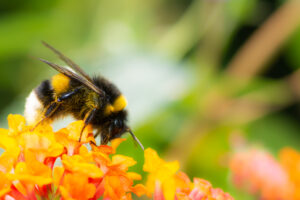Need Help? Call Us On 0161 776 9832 For Expert Pest Control Advice on Identifying Pest Infestations And Help Solve Your Pest Problem.
Buzzing Insects – Understanding Bees and Wasps
For most people, it is not easy to tell the difference between bees, wasps and other stinging insects, especially from afar. It is straightforward to find yourself in the middle of a swarm - and an attack by a multitude of angry bees or wasps can be a harrowing, even fatal, experience. Most people who come across swarms of bees on their property have no idea what they should do to protect themselves and their loved ones.
Characteristics of Wasps
Wasps are considered pests, and they live in colonies of hundreds. They are highly aggressive and will deliver several painful stings at the slightest provocation. Wasps are classified either as solitary or social with hundreds of known species. However, all species are considered pests that require professional pest control. All wasps have characteristic slender bodies that are about 2cm long with very narrow waists. They come in an array of colours ranging from black, red, yellow and even blue. Only female wasps can sting.
 The Common Wasp and the German Wasp are the most common species in the UK, capable of delivering painful stings. These two species have yellow and black bodies, about 17mm long and they like building nests in sheltered places with easy access to the outside. Social wasps live in big colonies and are considered dangerous. On the other hand, solitary wasps are more significant but less dangerous because they don’t live in colonies.
The Common Wasp and the German Wasp are the most common species in the UK, capable of delivering painful stings. These two species have yellow and black bodies, about 17mm long and they like building nests in sheltered places with easy access to the outside. Social wasps live in big colonies and are considered dangerous. On the other hand, solitary wasps are more significant but less dangerous because they don’t live in colonies.
Hornets are dangerous because they can sting and bite. Whole colonies of around 700 workers can attack a perceived threat in defence, stinging repeatedly. They are larger than wasps, growing to approximately 40mm. They have orange abdomens that have brown stripes. Hornets feed on sap and other small animals and are mainly found in woodlands. They can easily make barns, trees and attics their home.
Hoverflies are easily confused with wasps because of their size, black and yellow bodies and tiny waists, but they are harmless because they do not sting or bite. Unfortunately, this resemblance has earned the hoverfly a lousy reputation. The hoverfly gets its name from its habit of hovering or nectaring over flowers.
Characteristics of Bees
There are many species of bees, and most people mistake bees for wasps, mainly because of their bright colours ranging from brown, red and yellow. Their body size is similar to that of wasps. The bodies of bees are covered in hair. One of the main differences between bees and wasps is that bees can only sting once and be less aggressive. Not all species of bees can sting. When you notice a bee colony in your home, it is still important to get pest control services to remove them.
Bees fly in swarms when they are in search of a suitable place to create new nests. Bee swarms can easily be mistaken for wasp colonies. Bee swarms will usually fly away in a few days if they don’t find a place to create a nest.
Honey bees are a species of bees that are kept for their honey-making skills, hence their name. They are usually brown or orange with distinct dark lines. They live in large colonies of over 30,000 bees, and they can make their homes in attics, hollow roofs and trees. They collect nectar and turn it into beeswax and honey. Therefore, it is essential to seek the help of pest control experts to help in relocating swarms to safer places or farms.
It is easy to confuse bumblebees with honey bees because of their similar colour. However, Bumbles bees have much bigger bodies with more hair than honey bees. They are not aggressive and will only sting to defend themselves.
Solitary bees are loners nesting close to other solitary bees. They usually make their nest in sandy soils. Due to their reclusive nature, they are harmless, and they do not sting. They closely resemble honey bees, but they can be identified by their bright orange pollen brushes, which are located on their bellies. These bees are good pollinators and, therefore, an essential part of the ecosystem. Mason bees are an excellent example of solitary bees and are commonly found in North Britain. They typically like to nest in holes and crevices in the mortar that are exposed to the sun. Again, they are considered harmless and will never attack.
Clearing up bee or wasp nests is a job for professional pest control experts who have the right skills to identify the particular bee or wasp and deal with the nest accordingly. It is important to remember that these creatures play a vital role in the environment. Should you notice bees or wasps or buzzing insects in your surroundings, ensure that you report this to get help. Do not attempt to deal with the nest yourself.

